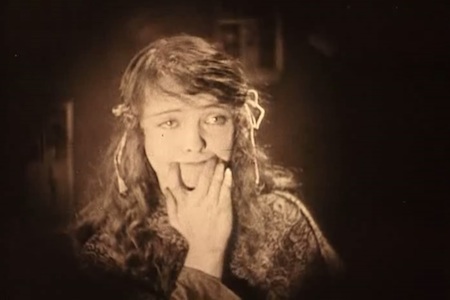Born: October 14, 1893*, Springfield, OH
Died: February 27, 1993, New York, NY
Gish is so hypnotic that the audience finds itself straining to catch the merest movement of an eyelash.
—Kevin Brownlow
It was Mary Pickford who introduced Lillian Gish to director D.W. Griffith. As the quintessential waif, Gish fit the bill for the sentimental Victorian melodramas that became Griffith’s specialty. Together, they clashed on the interpretations of some of silent film’s greatest accomplishments, including The Birth of a Nation (1915) and Orphans of the Storm (1922). She openly shared her opinions with the famous director, who in turn shared his respect for her drive to add artistry to the new medium. His dramatic instinct for throwing a helpless victim into a cruel and tension-filled climax was heightened by Gish’s transcendent innocence.
Credited with pioneering fundamental screen acting techniques, Lillian Gish was a true original. Her fragile, innocent face was a marvel of subtle nuances. Her expressive eyes and restrained gestures were the perfect match for Griffith’s trademark close-ups. Other actors who had spent years refining their craft on the stage and in vaudeville shows continued with their broad, melodramatic movements on the film set; every action was accompanied with flailing arms that forced other actors to move out of their way and reposition themselves in the camera’s eye. Emphasized by the flickers of film projectors, these jittering, overblown theatrics simply drew laughter from audiences. In contrast, the vulnerable and virginal Gish mesmerized moviegoers by exerting control over both her emotions and her body. She remained stationary and would simply stoop or cower slowly when another actor became agitated. With soft steps, she would glide slowly out of a scene, halting just momentarily before a final exit. Audiences had time to study and assess the finer points of her performances.
Even more amazing, Lillian Gish had no contemporaries or mentors in the field of screen acting. She imitated no one. All of the craft that she brought to her roles was instinctual. Many of her habits in movement and timing have become the time-tested preferences for capturing performances on film and are still in common use today. She was hailed as the first serious movie actress, and her early shorts became training films for scores of actors making the transition from the theater. Gish gracefully accepted the moniker “first lady of the silent screen.”
Her most celebrated roles were popular largely because of her persistence in making them realistic. In Broken Blossoms (1919), she huddles in a closet while her abusive father* hunts throughout the house, looking to beat her. Griffith wanted to film just a few seconds of her terrified face, but Gish asked that the camera be left to roll on, as she added levels of fright to her beautiful countenance. The scene would prove to be the film’s most powerful. In another film, Way Down East (1920), a perilous trip downriver on an ice floe was called for, and Gish insisted on performing in a real blizzard without a stunt double. The scene captured the immediacy of the panic and became another hallmark in silent films.
After graduating from the Griffith stock company in 1923, she excelled at MGM studios in literary adaptations, including La Bohème (1926), The Scarlet Letter (1926) and The Wind (1928), as well as her first sound film, One Romantic Night (1930).
She decided to work with several minor studios and tried her hand at producing her own scripts in the late 1920s, exercising total control over scripts, supporting roles, crew members and producers. She had her choice of directors; among the top helmsmen she selected were King Vidor and Victor Sjöström. She displayed a keen eye for talent and hired the witty Dorothy Parker to write the titles for the successful Remodeling Her Husband (1920), the first film Gish tried her hand at directing.
In the late twenties, Gish’s popularity began to fade as talkies took the attention of audiences. She returned to Broadway in 1930, and continued to act on the stage for the next half century. Gish was resistant to sound pictures because she believed that silent features possessed a greater ability to touch people’s emotions. Despite these feelings, some of her finest work was done in the sound era. Her majestic presence appeared again in the David O. Selznick production of Duel in the Sun (1946). Her performance earned her an Academy Award nomination and, combined with a role in the Oscar-winning Portrait of Jennie (1949), signaled that Lillian Gish had a secure place in sound pictures. In fact, her angelic image earned her a powerful role in the cult classic Night of the Hunter (1955), in which she embodied the soul of goodness; her scenes of reading scripture to ward off the coming evil are some of the most memorable in sound films.
A special Oscar was awarded to Gish in 1970 for her “superlative artistry,” and she accepted honors from the Kennedy Center in 1982. Her last film appearance was at the age of ninety alongside Bette Davis in The Whales of August (1987). A poignant performance, it was a nostalgic curtain call completing the most respected body of work in the history of motion pictures. While accepting a lifetime achievement tribute from the American Film Institute in 1984, she recalled a favorite quote from John Barrymore that summed up the power of moving images: “That camera is more dissecting than anything that’s ever been invented. You stay in front of it long enough and it tells what you had for breakfast.”
To read all the republished articles from ‘The Film 100,’ go to Reintroducing the Film 100 here on Keyframe.
*Editor’s note: Gish’s birth date has been corrected from original publication, as has the familial relationship of her abuser.





